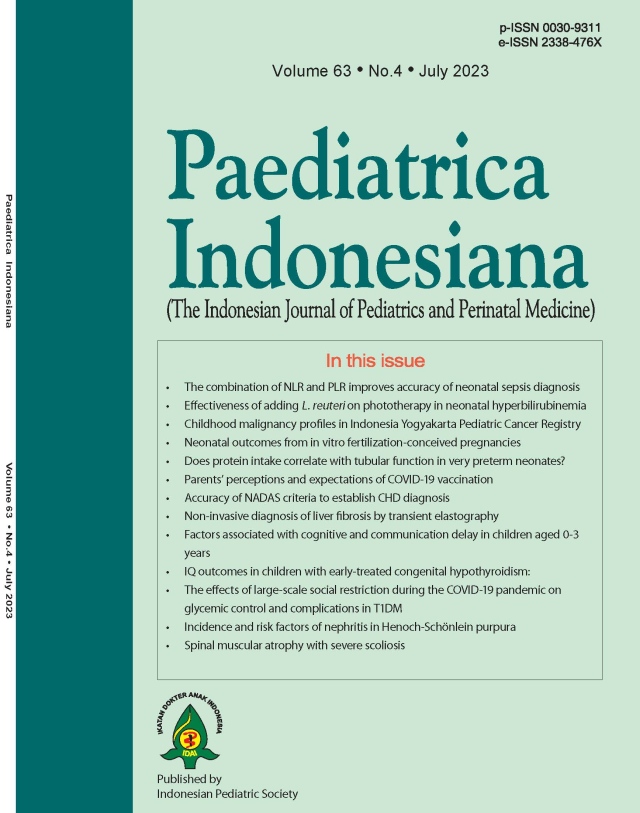Accuracy of NADAS criteria to establish diagnosis in children with suspected congenital heart disease
Abstract
Background The majority of congenital heart disease is diagnosed during evaluation of a murmur detected either during a routine follow-up or while assessing an intercurrent illness. NADAS criteria might be useful as a screening test to differentiate pathologic from innocent murmurs.
Objective To assess the accuracy of NADAS criteria in diagnosing pathology in children with suspected congenital heart disease.
Methods This diagnostic study included children aged 1 month - 12 years who visited the Outpatient Pediatric Cardiology Clinic at Haji Adam Malik General Hospital, Medan, North Sumatera. Inclusion criteria from history and physical examination were recurrent acute respiratory illness (ARI), poor nutritional status, failure to thrive, cardiac murmurs, and/or a history of cyanosis.
Results Seventy children underwent NADAS screening, of whom 60 had CHD. In the <5-year age group, 63.3% had heart disease. All patients had poor nutritional status, both CHD and non-CHD patients. All CHD patients had an abnormal electrocardiogram (ECG), while 88.33% had a history of recurrent ARI, 80% had abnormal chest x-ray, and 55% had abnormal S2 heart sound on auscultation. A grade 3 or higher systolic murmur was found in 78.33% of patients who had CHD. There were 55 children who had a NADAS score of 3 or higher, of which 53 children with CHD and 2 children non CHD (1 of the 2 children non CHD showed only 3 minor criteria of the NADAS score and had infantile fibrosarcoma). The other 15 children had a NADAS score of less than 3 with 7 children with CHD and 8 children without CHD.
Conclusion The NADAS criteria can be used as a screening test to diagnose disease in children suspected of having CHD for cut-off score at 3 (1 major + 2 minor), with 87.14% accuracy, 88.33% sensitivity, 80% specificity, and 0.883 AUC value.
References
2. Djer M, Madiyono B. Tata laksana penyakit jantung bawaan. Sari Pediatri. 2000;2:155-62. DOI: https://doi.org/10.14238/sp2.3.2000.155-62.
3. Frank JE, Jacobe KM. Evaluation and management of heart murmurs in children. Am Fam Physician. 2011;84:793-800. PMID: 22010618.
4. Pelech AN. Evaluation of the pediatric patient with a cardiac murmur. Pediatr Clin North Am. 1999;46:167-88. DOI: https://doi.org/10.1016/s0031-3955(05)70111-5.
5. Macicek SM, Macias CG, Jefferies JL, Kim JJ, Price JF. Acute heart failure syndromes in the pediatric emergency department. Pediatrics. 2009;124:e898-904. DOI: https://doi.org/10.1542/peds.2008-2198.
6. Van der Linde D, Konings EE, Slager MA, Witsenburg M, Helbing WA, Takkenberg JJ, et al. Birth prevalence of congenital heart disease worldwide: a systematic review and meta-analysis. J Am Coll Cardiol. 2011;58:2241-7. DOI: https://doi.org/10.1016/j.jacc.2011.08.025.
7. James M, Poornima K, Ninan PJ. Evaluation of children with cardiac murmur using NADAS criteria. Int J Contemp Pediatr. 2018;5:363-7. DOI: https://doi.org/10.18203/2349-3291.ijcp20180406.
8. Biancaniello T. Innocent murmurs. Circulation. 2005;111:e20-2. DOI: https://doi.org/10.1161/01.CIR.0000153388.41229.CB.
9. St Pierre A, Khattra P, Johnson M, Cender L, Manzano S, Holsti L. Content validation of the infant malnutrition and feeding checklist for congenital heart disease: a tool to identify risk of malnutrition and feeding difficulties in infants with congenital heart disease. J Pediatr Nurs. 2010;25:367-74. DOI: https://doi.org/10.1016/j.pedn.2009.04.009.
10. Rahim F, Younas M, Gandapur AJ, Talat A. Pattern of congenital heart disease in children at teritiary care centre in Peshwar. Pak J Med Sci. 2003;19:19-22. Available from: https://www.pjms.com.pk/issues/janmar03/article02.pdf
11. Sjarif DR, Anggiawan SL, Putra ST, Djer MM. Anthropometric profiles of children with congenital heart disease. Med J Indones. 2011;20:40-5. DOI: https://doi.org/10.13181/mji.v20i1.426.
12. Hagau N, Culcitchi C. Nutritional support in children with congenital heart disease. Nutr Ther Metab. 2010;28:172-84. DOI: https://doi.org/10.1177/2150135115576929.
13. Roman B. Nourishing little hearts: nutritional implications for congenital heart defects. In: Parrish CR, series editor. Nutrition issues in gastroenterology, Series #98. Practical Gastroenterology. 2011:11-34.
14. Baraas F. Kardiologi klinis dalam praktek diagnosis dan tatalaksana penyakit jantung pada anak. Jakarta: FKUI; 1995. p. 236-43.
15. Cabalka AK. Physiologic risk factors for respiratory viral infections and immunoprophylaxis for respiratory syncytial virus in young children with congenital heart disease. Pediatr Infect Dis J. 2004;23:S41-5. DOI: https://doi.org/10.1097/01.inf.0000108220.94201.1a.
16. Allen HD, Franklin WH, Fontana ME. Congenital heart disease: untreated and operated. In: Emmanoulides GC, Riemenschneider TA, Allen HD, Gutgesell HP, editors. Moss and Adams heart disease in infants, children, and adolescents. 5th ed. Baltimore: Williams & Wilkins; 1995. p. 657-64.
17. Gessner IH. Congestive heart failure. In: Gessner IH, Victoria B, editors. Pediatric cardiology. A problem-oriented approach. Philadelphia: Saunders; 1993. p. 117-29.
18. Felner JM. The second heart sound. In: Walker HK, Hall WD, Hurst JW, editors. Clinical methods: the history, physical, and laboratory examinations. 3rd ed. Boston: Butterworths; 1990. Chapter 23. Available from: https://www.ncbi.nlm.nih.gov/books/NBK341/.
Copyright (c) 2023 dr Rahmawati

This work is licensed under a Creative Commons Attribution-NonCommercial-ShareAlike 4.0 International License.
Authors who publish with this journal agree to the following terms:
Authors retain copyright and grant the journal right of first publication with the work simultaneously licensed under a Creative Commons Attribution License that allows others to share the work with an acknowledgement of the work's authorship and initial publication in this journal.
Authors are able to enter into separate, additional contractual arrangements for the non-exclusive distribution of the journal's published version of the work (e.g., post it to an institutional repository or publish it in a book), with an acknowledgement of its initial publication in this journal.
Accepted 2023-08-14
Published 2023-08-14













